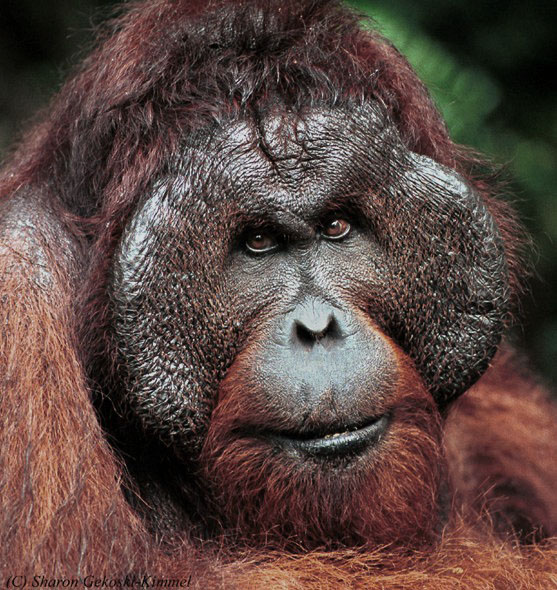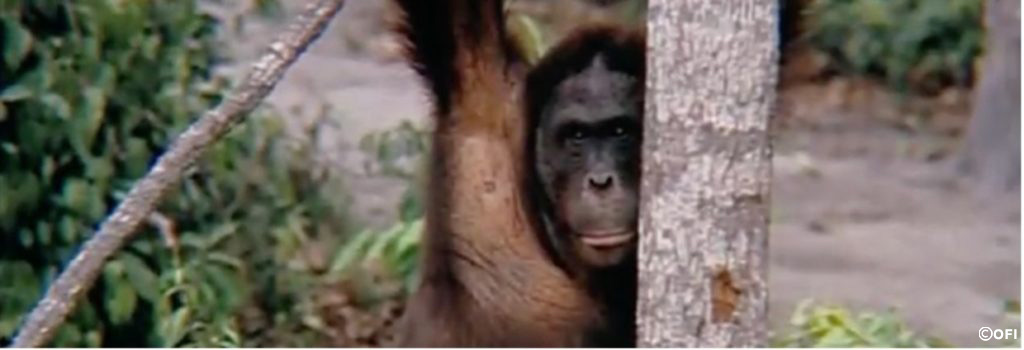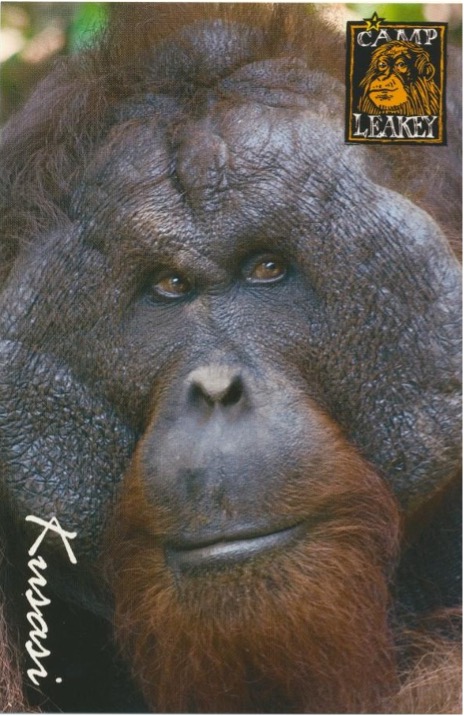
Kusasi was an extraordinary orangutan. Unlike most orangutans living in the wild, he was the star of his own film called “Kusasi: From Orphan to King,” which initially aired on BBC and PBS in 2005, subsequently shown worldwide. Kusasi also became famous as the dominant Camp Leakey adult male orangutan. Kusasi first came to Camp Leakey in August 1978. He was an infant brought in by Indonesian Forestry officers. He was scrawny and recently captured. No doubt, his mother had been killed in order to obtain him. Sometimes it is difficult to judge the age of young orangutans. Wild infants are often much smaller than well-fed “pet” orangutans who are sometimes pampered when they are babies. We initially estimated that Kusasi was eighteen months old when he first arrived. But now in retrospect, he was probably somewhat older when he first came. He was probably at least three years of age. Orangutan infants stay small for several years and do not have a growth spurt until their fourth of fifth year of age.
Kusasi didn’t stay at Camp Leakey very long. While he was still in his quarantine cage, he disappeared! The cage door was open. We suspect it was opened by a curious Camp Leakey orangutan. We didn’t think that infant Kusasi could be far away. We searched and searched but couldn’t find him. We reluctantly concluded that he must be dead. I even mentioned his disappearance and possible death in a report I later wrote to the Indonesian government.
The months rolled by.
Eighteen months later, midday, an excited assistant ran up to me. He practically shouted, “There is a wild infant at the dining hall!” My immediate thought was, Wild infant? How could that be? If there was a wild infant, there had to be a mother. I raced over to the dining hall and sure enough there was a large orangutan infant clinging to the outside wire of the wrap-around dining hall window. But there was no mother. I was staring at the infant in disbelief when one of my students suddenly appeared, took one look, and exclaimed, “Kusasi! It’s Kusasi!” A chorus of local assistants agreed. It was Kusasi.
Kusasi had survived eighteen months in the wild. An orangutan infant surviving on his own in the forest seemed improbable. But as the months wore on, I began to understand how Kusasi had survived as an infant in the wild without his biological mother. He probably had not been on his own. He was a feisty infant. He was a survivor. By this time, I had discovered that orangutans are “adopters.” Wild born orangutans at Camp Leakey occasionally adopted unrelated infants who had been brought to Camp under varying circumstances, mostly as volunteered or confiscated ex-captives. I began to suspect that infant Kusasi had survived in the wild by attaching himself to a wild female. This was his strategy with the dominant adult female at Camp Leakey, Siswoyo.
Siswoyo spent much time in the forest, but she often came, with clinging infant Siswi, to the feedings at the end of the bridge. Siswoyo did not adopt Kusasi. Kusasi adopted Siswoyo. She tolerated him, which is saying something for a “bossy” dominant adult female orangutan. When Siswoyo marched down the causeway that linked the Camp to the feeding site, Kusasi would follow in her wake a few meters behind. Wherever Siswoyo went, Kusasi was sure to follow. The other orangutans became used to Kusasi always accompanying Siswoyo. If you didn’t know any better, it would seem that Kusasi was Siswoyo’s older offspring, the one who had been ejected from the nest when new infant Siswi was born. A similar behavior had probably been the key to Kusasi’s survival in the wild. Wild orangutans are remarkably tolerant of youngsters. This is even true of adult males, as long as the youngster is not screaming or vocalizing loudly. Like grumpy old men, adult males don’t like noise. But females seem especially tolerant of youngsters. In all probability, when the wild female he had adopted foraged, Kusasi followed and foraged in the same tree.

By the mid 1980s, Kusasi had grown into a strapping young adolescent male. As the apparent son of the dominant female, he always had first access to milk and fruits provided at feedings. He interacted with humans. His approaching familiar people at Camp was commonplace. We were friends and he had no hesitation in initiating contact with me, especially when he wanted something. But our relationship was such that we almost never engaged in playful encounters. In the orangutan world, males and females become increasingly separate as the males mature. I suspected that, for Kusasi, I was just another Siswoyo.
Gradually, Kusasi started disappearing into the forest for longer and longer periods of time. Sometimes he would be gone for months at a time. Whatever Kusasi was doing in the forest resulted in him coming back to Camp Leakey covered with wounds. He sometimes had puncture marks so deep in his flesh that one might have thought he was fighting saber-toothed tigers. He sought out my presence and showed me his battle injuries. I would bring out antiseptic fluid like iodine to clean his wounds and then put antibiotic salve on them. Sometimes he would take the antibiotic salve out of my hand and taste it. I was always surprised how quickly his wounds healed. The recuperative powers of orangutans never cease to amaze me when it comes to flesh injuries.
By this time, Kusasi was already a subadult male. He was getting more feisty and somewhat more aggressive to other males in the vicinity. He also started palling around with Siswi. He seemed to show her affection and perhaps even mated with her, although he did not appear to be the father of her offspring.
While he was still a subadult male, Kusasi engaged in a seemingly friendly arm wrestle with a visiting middle aged Australian dentist. As soon as I saw them, I stopped the match by shouting in a loud authoritative voice. As the Australian dentist moved away from Kusasi, I noticed blood trickling down his arm. “Oh, it’s nothing,” the Australian said. I later discovered that the match had not been quite as friendly as it looked. Kusasi had cheated by biting the dentist’s arm as they were wrestling. Later, when Kusasi was fully adult with cheekpads, he actually had another arm wrestling match with our oldest volunteer, Mr. Ralph Arbus. Mr. Ralph was in his 80s at the time. Unlike the Australian dentist, Mr. Ralph was not a one-time visitor, but came repeatedly to volunteer over the decades. Kusasi knew him well. Kusasi did not bite him. When I asked Mr. Ralph what the dickens he was doing arm wrestling with a 300-pound orangutan, Ralph smiled sheepishly and said something about Kusasi and him being buddies.

Another older, white-haired volunteer, Mrs. JunAnn Holmes, also came repeatedly over the years to visit the Camp Leakey orangutans whom she dearly loved. One afternoon I was standing on my porch. I looked out and saw Kusasi rolling what appeared to be a huge tan beach ball on the forest path. To my horror, after a split second I realized the beach ball was Mrs. JunAnn, whose tan colored parachute cloth pants had ballooned out while Kusasi was rolling her. After a few rolls, Kusasi let her go and just walked away. As JunAnn got up from the ground, she explained that as Kusasi approached, she put one small banana of the two bananas that she was holding at the time into her pocket. Then she reached out and handed Kusasi the remaining banana in her hand. JunAnn explained that probably Kusasi was a bit annoyed with her because she was “holding out on him.” As Kusasi rolled her sideways on the ground, he reached into her pocket, took out the second banana, and walked away.
Kusasi always seemed somewhat curmudgeonly. He clearly regarded himself as our equal and was tolerant of us. But he was always independent. His real world was in the forest with other orangutans. He came and went. Over the years as he matured into a fully flanged adult male, he fought battles with other males to whom he was extremely belligerent. Unlike some other males, he did not even tolerate the presence of adolescent or subadult males in his vicinity. The numerous scars and wounds on his head and body were testimony to his pugnacious and aggressive nature as far as any and all other orangutan males were concerned.
As the years wore on, Kusasi’s dominant status did not diminish. As before, he came back from the forest with wounds. Under his thick orange hair, his body became a mass of scars. His cheekpads were chipped with cuts. The other males avoided him and ran away when they saw him. We generally did not follow Kusasi into the forest, and so did not see his combats with other males. We did, however, see Kusasi in the forest chasing other males. Kusasi had been the dominant male for almost a decade. We did finally see a combat between Kusasi and a wild male, named Win, who had come recently into the vicinity of Camp Leakey. Win seemed to be a grizzled street fighter like Kusasi. They fought twice. They could have fought more combats, but those were the only two we saw. Win won, which is why we gave him the name Win. We expected Kusasi to slink away and Win to stay. To our surprise, Win left. He was a wild orangutan. Male orangutans roam. Sometimes they stay. Sometimes they go. Perhaps there were no receptive females in the Camp Leakey area at the time. As abruptly as he had arrived, the champion gladiator Win left, leaving Kusasi as the dominant male. From Kusasi’s behavior, one would never have guessed that he had been defeated in any combat.
But some time later, we actually witnessed the dethroning of the King. This time, it was a local boy, not a heavyweight stranger wandering through. His name is Tom. Kusasi was on the feeding station platform at Camp Leakey when Tom arrived in the vicinity. Kusasi immediately jumped off the platform and started chasing Tom. Tom started running for his life, and then suddenly Tom turned around, faced Kusasi, and charged him. Tom had noticed that one of Kusasi’s arms looked broken and was being held up in Kusasi’s mouth so it would not flail uselessly by his side. We don’t know whether the arm injury was caused by a previous fight or by an accidental fall. Tom defeated Kusasi and badly wounded him. The assistants and local guides who were present broke up the fight. Kusasi escaped. We found Kusasi lying in the grass and ferns outside the forest near the path back to Camp Leakey. The love, affection, and respect that the local men, both assistants and guides, had for Kusasi was palpable as they gave him water and spoke soothingly to him. He was barely conscious. From then on, Tom was the King. Kusasi recovered. Whether he ever fought Tom again, I don’t know. But Kusasi seemed to physically shrink. His cheekpads began to droop. I once watched Kusasi eyeing a subadult male from some distance. Kusasi was still formidable enough that the subadult male did not approach him. But the subadult male did not flee from Kusasi’s presence as in the past, and Kusasi seemingly ignored him. In previous months and years, Kusasi would have charged and the subadult male would have fled just seeing Kusasi.

In Spring 2009, Kusasi vanished from the vicinity of Camp Leakey. Some people have even surmised that he died in 2009. But this is not the case. Six months after he vanished from Camp Leakey, he was seen on the main Sekonyer River some distance from Camp, heading downriver. There is an old saying that old soldiers never die, they just fade away. Kusasi, who was known as the King, gave up his throne to another King, and became one of those itinerant old adult male orangutans who roamed the forest with no home to call his own.
All the humans who knew Kusasi respected his strength, dignity, and magnificence. He reminded us of a street fighter who, by determination and perseverance, took over the throne. Kusasi has a legacy not only in people’s hearts, but also in the orangutans he left behind. When we started doing our genetic studies, we discovered that since he reached sexual maturity, he was father to more than a third of the genetically identified orangutan infants born to the wild born ex-captive females in the vicinity of Camp Leakey. He was probably father to most of the orangutans born in the ex-captive community during his decade-long reign.
Kusasi: Gone but never forgotten.



I enjoyed this article very much, and I feel extremely fortunate to have seen Kusasi at Camp Leakey in the early summer of 2008. He had a large and severe open wound on his head, and although I remember your sadness with his condition, it was still easy to see how magnificent he had been.
Beautiful story!
It was an honour to know him and spend time with him!